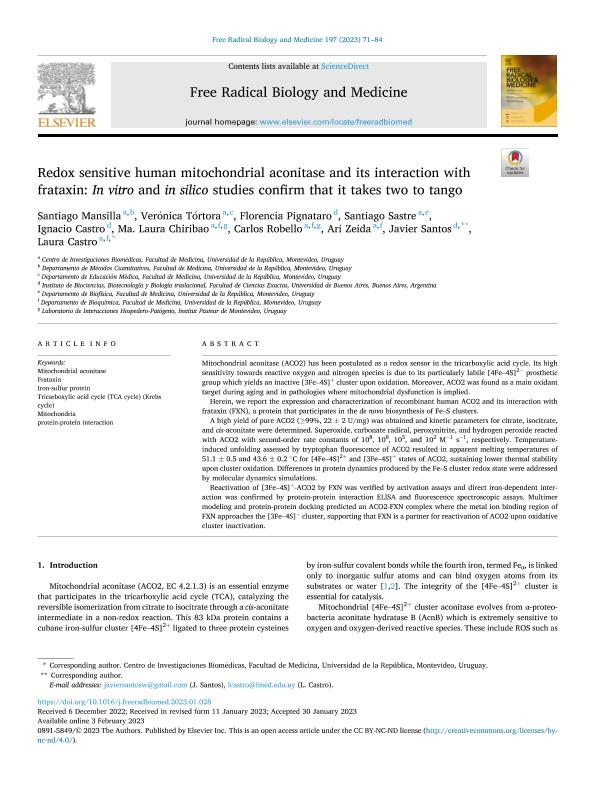Artículo
Redox sensitive human mitochondrial aconitase and its interaction with frataxin: In vitro and in silico studies confirm that it takes two to tango
Mansilla, Santiago Nahuel; Tórtora, Verónica; Pignataro, María Florencia ; Sastre, Santiago; Castro, Ignacio; Chiribao, María Laura; Robello, Carlos; Zeida Camacho, Ari Fernando
; Sastre, Santiago; Castro, Ignacio; Chiribao, María Laura; Robello, Carlos; Zeida Camacho, Ari Fernando ; Santos, Javier
; Santos, Javier ; Castro, Laura
; Castro, Laura
 ; Sastre, Santiago; Castro, Ignacio; Chiribao, María Laura; Robello, Carlos; Zeida Camacho, Ari Fernando
; Sastre, Santiago; Castro, Ignacio; Chiribao, María Laura; Robello, Carlos; Zeida Camacho, Ari Fernando ; Santos, Javier
; Santos, Javier ; Castro, Laura
; Castro, Laura
Fecha de publicación:
02/2023
Editorial:
Elsevier Science Inc.
Revista:
Free Radical Biology and Medicine
ISSN:
0891-5849
Idioma:
Inglés
Tipo de recurso:
Artículo publicado
Clasificación temática:
Resumen
Mitochondrial aconitase (ACO2) has been postulated as a redox sensor in the tricarboxylic acid cycle. Its high sensitivity towards reactive oxygen and nitrogen species is due to its particularly labile [4Fe–4S]2+ prosthetic group which yields an inactive [3Fe–4S]+ cluster upon oxidation. Moreover, ACO2 was found as a main oxidant target during aging and in pathologies where mitochondrial dysfunction is implied. Herein, we report the expression and characterization of recombinant human ACO2 and its interaction with frataxin (FXN), a protein that participates in the de novo biosynthesis of Fe–S clusters. A high yield of pure ACO2 (≥99%, 22 ± 2 U/mg) was obtained and kinetic parameters for citrate, isocitrate, and cis-aconitate were determined. Superoxide, carbonate radical, peroxynitrite, and hydrogen peroxide reacted with ACO2 with second-order rate constants of 108, 108, 105, and 102 M−1 s−1, respectively. Temperature-induced unfolding assessed by tryptophan fluorescence of ACO2 resulted in apparent melting temperatures of 51.1 ± 0.5 and 43.6 ± 0.2 °C for [4Fe–4S]2+ and [3Fe–4S]+ states of ACO2, sustaining lower thermal stability upon cluster oxidation. Differences in protein dynamics produced by the Fe–S cluster redox state were addressed by molecular dynamics simulations. Reactivation of [3Fe–4S]+-ACO2 by FXN was verified by activation assays and direct iron-dependent interaction was confirmed by protein-protein interaction ELISA and fluorescence spectroscopic assays. Multimer modeling and protein-protein docking predicted an ACO2-FXN complex where the metal ion binding region of FXN approaches the [3Fe–4S]+ cluster, supporting that FXN is a partner for reactivation of ACO2 upon oxidative cluster inactivation.
Palabras clave:
ACONITASE
,
FRATAXIN
,
MITOCHONDRIA
,
INTERACTION
Archivos asociados
Licencia
Identificadores
Colecciones
Articulos(OCA CIUDAD UNIVERSITARIA)
Articulos de OFICINA DE COORDINACION ADMINISTRATIVA CIUDAD UNIVERSITARIA
Articulos de OFICINA DE COORDINACION ADMINISTRATIVA CIUDAD UNIVERSITARIA
Citación
Mansilla, Santiago Nahuel; Tórtora, Verónica; Pignataro, María Florencia; Sastre, Santiago; Castro, Ignacio; et al.; Redox sensitive human mitochondrial aconitase and its interaction with frataxin: In vitro and in silico studies confirm that it takes two to tango; Elsevier Science Inc.; Free Radical Biology and Medicine; 197; 2-2023; 71-84
Compartir
Altmétricas



